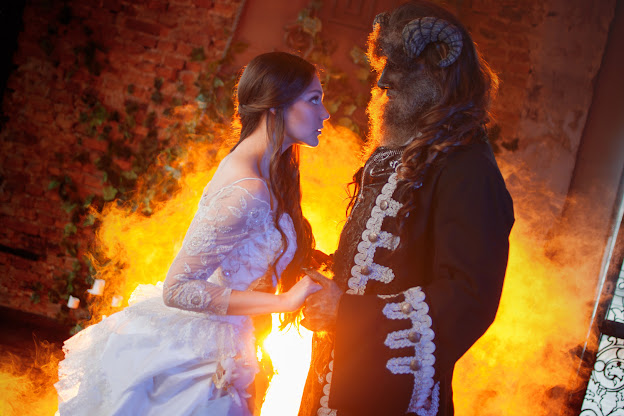What does the enchanted rose symbolize in "Beauty and the Beast"?
In "Beauty and the Beast," the enchanted rose takes on a central and profound role within the narrative, echoing the title of the tale and symbolizing a plethora of themes that interweave and shape the story's core essence. Time and again, the image of the rose blooms throughout the story, representing elements of beauty, love, transformation, and redemption that lie at the heart of the narrative.
"Beauty and the Beast," as a tale, places a strong emphasis on the notion of beauty, both in its inner and outer forms. The enchanted rose serves as a vivid reminder that true beauty transcends physical appearances. The Beast's outer appearance, initially fearsome and beastly, hides the kind and noble character within. This inner beauty, concealed behind a rough exterior, becomes a central theme within the story. In the grand tapestry of "Beauty and the Beast," the rose embodies this concept, reminding us that a person's worth and beauty go beyond their external form.
The enchanted rose also serves as a powerful symbol of love's transformative power. Love, depicted as the key to breaking the Beast's curse, is an enduring theme in "Beauty and the Beast." It is the development of love, nurtured slowly over time, that has the potential to transform the Beast back into a human. The image of the rose losing its petals one by one becomes a visual representation of this process. The gradual fall of the rose's petals mirrors the gradual growth of love between the Beast and Belle. It reminds us that love is not an instant infatuation but a deep and transformative connection that takes time to flourish.
In the tapestry of "Beauty and the Beast," the rose continually reemerges as an embodiment of the narrative's central themes. It signifies redemption and personal growth. As the Beast endeavors to find true love and break the curse, he undergoes significant character development. He learns to be kind, patient, and compassionate, transforming from a self-centered and harsh creature into a more humane and gentle being. His journey towards redemption aligns with the rose's gradual transition, illustrating that personal growth and redemption are achievable when love and kindness prevail.
Beyond its thematic significance, the enchanted rose also fuels the narrative's tension and urgency. It acts as a countdown clock, with each fallen petal symbolizing time slipping away. The Beast's ultimate fate hinges on finding love before the last petal drops. This ticking clock adds a layer of suspense to the story, propelling the plot forward and heightening the emotional stakes.
"Beauty and the Beast" explores the idea that love is not solely based on appearances. The story's central relationship between Belle and the Beast underscores this concept. Belle's journey in the castle, her interactions with the enchanted objects, and her growing affection for the Beast reveal the transformative power of genuine love. As the rose continues to lose its petals, it serves as a constant reminder of the Beast's need for this deep and authentic love. The story beautifully illustrates how Belle, despite the Beast's fearsome exterior, perceives the goodness within him, thus reinforcing the narrative's message that inner beauty is more significant than outer appearances.
Furthermore, the rose's symbolism extends to other characters within the story. The enchanted household objects, such as Lumière, Cogsworth, and Mrs. Potts, are not just servants but also friends who deeply care about the Beast's well-being. Their connection to the rose's fate underscores their emotional investment in his redemption. They too long for their human forms to be restored, and the rose's condition reflects their own transformation and ultimate freedom.
The concept of the enchanted rose also challenges conventional fairy tale notions of love. In many traditional tales, love at first sight prevails, but "Beauty and the Beast" emphasizes the gradual development of love. It posits that love is a process, something that must be nurtured and cultivated. The enchanting rose, as it slowly loses its petals, is a constant reminder that love must be deep and authentic to break the curse. This emphasis on the gradual and transformative nature of love sets "Beauty and the Beast" apart from traditional fairy tales and offers a more complex and realistic portrayal of love and relationships.
The rose, as a recurrent motif, not only encapsulates the themes of inner beauty and love but also speaks to the universal human experience of the passage of time. Time, like the petals of the enchanted rose, is fleeting. The gradual descent of the petals reminds us of our own mortality and the importance of cherishing the moments we have. This relatability makes "Beauty and the Beast" a story that transcends its fairy tale origins, as it touches upon the very fabric of human existence.
The rose is a symbol of hope. As long as there is a single petal remaining, there remains hope for the Beast's redemption. This theme of hope is especially poignant in a story where despair and isolation initially seem insurmountable. It serves as a reminder that, even in the darkest moments, there is always a glimmer of hope that things can change, and love can conquer all. The rose's role in representing hope makes it a beacon of light in a tale that grapples with transformation and growth.
In "Beauty and the Beast," the enchanted rose influences not only the central characters but also the choices they make. Belle's discovery of the rose and the Beast's curse serves as a pivotal moment that impacts her own decisions. She willingly stays in the castle, eventually leading to her deepening connection with the Beast. This pivotal moment represents the idea that one small act of compassion and understanding can set in motion a series of events that transform lives and relationships. It reinforces the message that even the smallest act of kindness can have a significant impact.
The enchanted rose also reinforces the narrative's exploration of change and the power of love to inspire transformation. The Beast's metamorphosis is not merely a physical change but a profound inner transformation as well. The gradual fall of the rose's petals symbolizes the time required for real change to occur. It suggests that growth and personal development are gradual processes that involve patience and commitment. The rose's presence, therefore, underlines the idea that love is a catalyst for change and personal growth.
Moreover, the rose stands as a reminder that external circumstances do not define one's destiny. The Beast's initial transformation into a beastly form is not his permanent state. The petals of the enchanted rose represent that change is always possible, even when it seems unlikely. This message is especially resonant in a world where many individuals struggle with self-esteem and personal growth, reminding them that they are not bound by their past or their outward appearances.
In "Beauty and the Beast," the enchanted rose is not just a static symbol; it evolves along with the characters and their relationships. Its changing condition mirrors the changing dynamics in the castle, particularly the blossoming connection between Belle and the Beast. As the two characters begin to understand and care for each other, the rose becomes a reflection of their deepening bond, turning it from a symbol of despair into a symbol of hope and love.
The enchanted rose, as an enduring symbol within "Beauty and the Beast," serves as a narrative thread that connects and enriches the story's themes of inner beauty, love, transformation, redemption, hope, and change. It resonates with audiences on a universal level, reminding us of the fleeting nature of time and the potential for growth and transformation, even in the darkest of circumstances. The rose, with its graceful petals falling one by one, encapsulates the essence of the tale, making "Beauty and the Beast" a timeless and profound narrative that continues to captivate hearts and minds.
In summary
"Beauty and the Beast" is a timeless tale with a deep and multifaceted narrative. The enchanted rose, symbolizing beauty, love, transformation, and redemption, is a central and recurring motif throughout the story. It beautifully encapsulates the core themes of the narrative, such as the significance of inner beauty, the transformative power of love, and the urgency of redemption. As the petals of the enchanted rose continue to fall, the story serves as a reminder that true love is patient, deep, and capable of bringing about profound change.







.jpg)

.jpg)


0 Comments